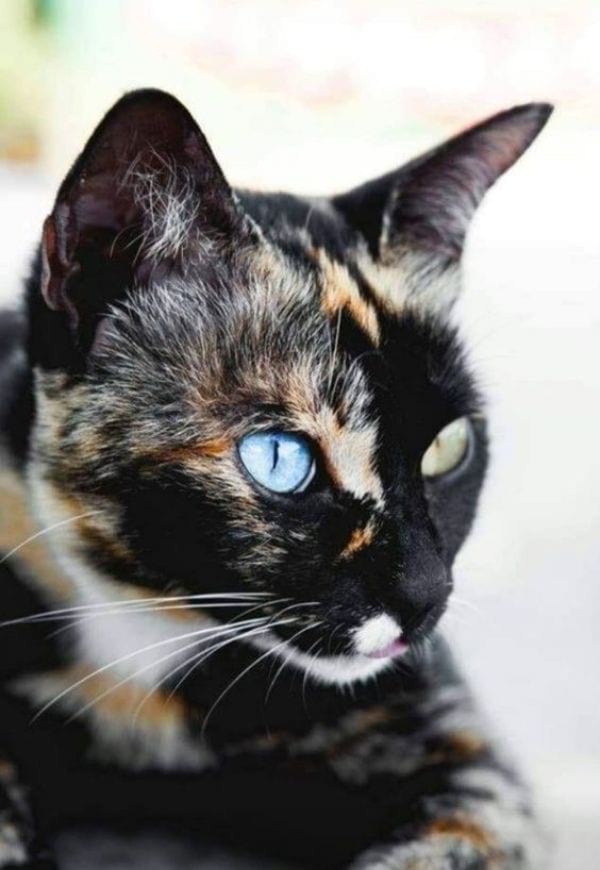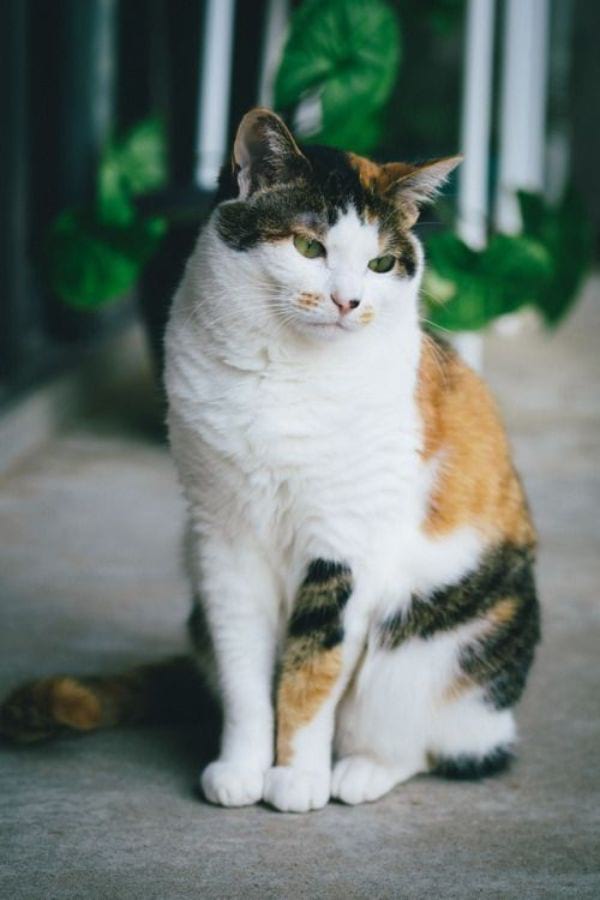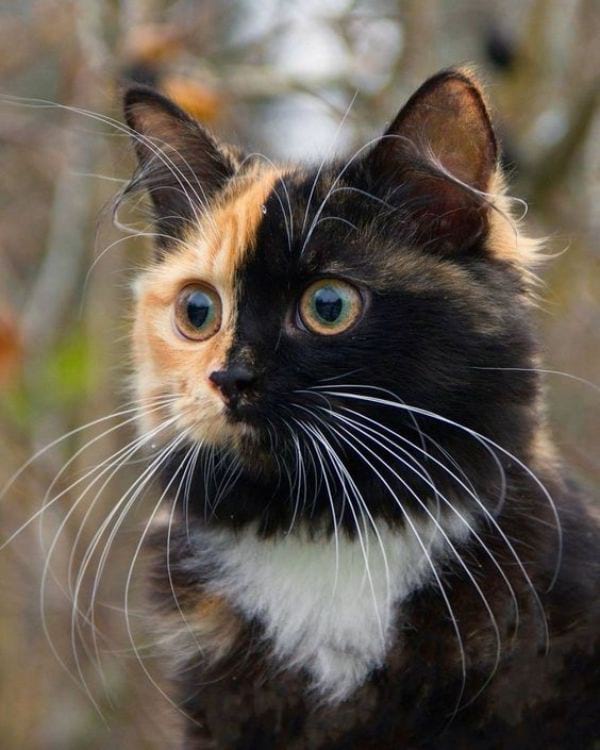The main difference between tortoiseshell and calico cats is that calico cats have more distinct red and black patches, as well as more white in their coat.
Many cat owners consider multicolor pets as their personal symbol of fortune. A tortoiseshell coloration and calico color are among the rarest when it comes to the feline buddies. Some people confuse these two types of cat’s coat coloring. But there is a range of differences in the context of tortoiseshell kittens and calico-coated kitties.
Overview of Tortoiseshell
A cat tortie is a bewhiskered pet companion with fur similar to the turtle’s shell. The coat can contain ginger red, brown, cream, black patches. This coloration can be met in different breeds.
The tortoiseshell pattern is common for Maine Coons, Persians, Cornish rex, British and American Shorthair males and females. Even though the individual features of characters are typical for felines of a certain breed, there is a special tortoise-shell cat’s behavior to take into consideration.
So-called tortitude is notable for females with tort coloration. They are independent and have a spicy character with their own mood and exceptional tortoiseshell cat personality. It means that you can become an owner of the rather stubborn and temperamental bewhiskered lady with an extremely attractive appearance!
The notable feature of all the torties is the absence of white color on their fur. All the representatives of the tortoiseshell cat breeds obtain light creamy or yellowish patches but not show-white ones. This is the distinctive peculiarity of torties. When it comes to the calico vs tortoiseshell comparison, white color can be met only in the calico-friendly breeds.
Note that there is a special tortie cat breed. These felines are born in different litters (Maine Coons, Ragdolls, Persians, etc.). Tortie cats are usually females. It is rather a rare phenomenon to meet the tortoiseshell male cat. But if the tort he-cat appears in the litter, be ready that your buddy is absolutely sterile.
Among other interesting facts that can describe such cute and eye-catching multi-colored cats as torts are:
- Felines tortoiseshell and white cat pets are about different sorts of things. Torts do not obtain any white spots, shadows, and patches on their coats.
- Torts can be of dense or dilute coloration. Everything depends on the intensity and brightness of the color patterns. The lighter are patches and stripes, the more likely you have a dilute tortie.
- All the multi-colored cat breeds are lucky ones. Tortie kittens are not an exception. Adopt a tortoiseshell feline to have a lucky four-leaf clover at home!
Overview of Calico
A tender coloration that contains light harmonious patches and spots on the fur is about calicos. In comparison with torts, calico-friendly felines always obtain white color on their coat.
Calico kittens are three-colored bewhiskered buddies with very interesting pattern combinations. For example, you can see the happy blend of white, lilac, and blue or cream, brown, and white as well.
It is worth noting that there are dense and dilute coloration types to take into account. A dilute calico cat can impress with its gorgeous look. All the colors are light and far from bright or intensive ones. Dense calico cat colors are usually black, dark grey, orange, and deep brown. Do not forget that the third color in the three-component mix is always white!
Among calico cat breeds are Maine Coons, Persians, Ragdolls, Cornish Rex, etc. This list is rather long to mention all the buddies at once. But note that calicos are not the separate-standing breed. It is only a coloration type that can be met in various litters.
As the brown, black, or blue tortoiseshell cat, a calico has its own features of character.
The three-colored coloration brings to felines the sense of freedom, independence, and smartness. A calico pet personality is about relaxed and loving pet companions who are not lacking in their gentle behavior and curiosity.
These multicolored felines are rather rare (both dense and dilute ones). Most short-hair and fluffy calico cat pets are females. Males are born rarely (1:3000 chance to have a he-cat), and they are 100% sterile. What is a calico cat? Here are some facts to describe this feline better:
- There are exotic color patterns to take into account. Among them are calico tabby cats (calico tabby mix) and even calico tortoiseshell buddies.
- If you are puzzled by calico vs tortoiseshell coloration, find a white color to determine the calico-friendly pet. Even the calico-tortoises\hell mix includes 15-25% of white color.
- Usually, the content of white color is 25-50%. But there are many types of calico cats. Some of the felines are 75% white!
- Calico and tortoise cat color patterns bring luck. At the very least, many owners of these bewhiskered buddies believe so. Adopt a multicolor feline like a grey, white, and black calico cat to check it!
Read more: Names for Calico Cats
What’s the Difference Between Calico and Tortoiseshell Cats?
The main difference between these two color patterns is the presence of white. Black, blue, grey tortoiseshell cat pets do not have white-colored spots on their bodies at all. They can obtain only some sort of cream, light yellow, or orange color. At the same time, dense muted calico felines always have white. They are covered by 25-75% of white-colored coat patches.
Why Are Tortoiseshell and Calico Patterns Different?
These patterns are really similar. But the dominance of white color really matters. For example, even a dark calico cat will have white spots on the face, paws, or back. At the same time, a back tortoiseshell cat is lacking in white-colored coat shadows, stripes, and patches.
Pigment Genes in Cats
Numerous genetic variations are responsible for the color pattern. For example, a cream-colored cat should obtain a cream pigment gene together with two other ones (black and grey for torts or white and lilac for calicos). It is impossible to list all possible genetic variations. A calico tortie mix will be performed if three pigment genes take place:
- White;
- Brown/grey/black/orange;
- Reddish/cream/lilac/blue/smoky.
Calicos have a distinct hereditary trait known as “piebald.” It essentially results in unpigmented skin and white fur.
Felines can be born with both X and Y chromosomes. A female cat is produced by two Xs, whereas a male cat is produced by an X and a Y. These X chromosomes are thus in charge of determining fur color. Tortie cats contain both orange and black variants of these genes (also known as the “XB allele” and “Xb allele,” respectively), giving them their distinctive tortoiseshell look.
Basic Differences Between Torties and Calicos
What is a tortie cat? This is the feline with the specific white-free color pattern similar to the turtle’s shell. What does a calico cat look like? This is a feline with three colors mixed together when it comes to its coat coloration. The white color is a must for calicos. Let’s take a closer look at other tortoiseshell vs calico differences and similarities.
Differences
- A typical tortie is the three-colored bewhiskered buddy with no white color pattern on the coat.
- Dense and dilute tortoiseshell cats mostly obtain black, brown, and grey bodies with orange, yellow, or reddish spots and stripes (tabby kittens).
- A cream, orange, grey calico cat is the feline with dominating white color and patches of other coloration (blue, lilac, grey, brown, etc.).
- A tabby calico cat obtains beautiful multicolor stripes of different color intensities.
Similarities
- Tortoiseshell and calico cats are about some special color pattern – it is not a breed.
- Torts and calicos are tabby-friendly (brindle cats are possible). You can meet both a tortie tabby cat and a striped calico cat.
- Both torts and calicos in most cases are females (99%). All the males are sterile.
- It is impossible to breed any kind of tortoiseshell (tabby, black, etc.) or calico (dilute, dense, etc.) felines. Random genetics take place.
Are Calico and Tortoiseshell Cats Rare?
Yes, these color patterns are very rare in the context of males (1:3000). Females can be met rather often in different breeds. The orange and black cat pigment genes should be presented to display the tortie or calico classic coat.
Speaking about chromosomes, XX female code is the most usual. The males should have an extra Y chromosome (XXY) to have a tortoiseshell or calico color pattern. The black and orange cat pigment gen is attached to the X chromosome. This way an orange tabby kitten with tort and calico coloring appears.
So How Could a Male Cat Possibly Be Calico or Tortie if They Need the XX Chromosomes of a Female?
Are tortie and calico cats always female? Not exactly of this kind. Males are seldom born if the stars are aligned. An extra chromosome takes place, so males have the special gene code (XXY). This phenomenon is also known as Klinefelter syndrome. It explains the sterility of the male torties and calicos. With the special pigment genes, the following variations of coloration are possible:
- Brown tabby cat (torts and calicos);
- Dense and dilute tortie cat (bright and light-dark colors);
- Dense and dilute calico tabby cat, etc.
Variations Among Calicos and Torties
There are different mixes to take into account. Even a tort tabby and white cat variation is possible. Let’s take a look at all the mixes and coloration variants together.
Tortoiseshells with White Vs Calicos
Sometimes a very rare coat coloring appears – this is the tort with random white patches on the fur. The white-colored spots cover only a quarter of the feline’s body. This pattern is possible for orange tabby cats as well (due to the orange pigment gen).
Dilute Calicos, Calibys, Torbies
These variations appear more often. Dilute calicos are notable for their pale color patterns. The mix of tabbies and calicos is called the calybis pattern. You can meet black, white, or grey tabby cat pets that are calico-friendly. The same story is about tabby tortoiseshell felines. Their slang name is torbies (for example a tort black tabby cat).
Mixed Calico Vs Tortoiseshell
Sometimes it is difficult to define the real color pattern when the rot and calico coloration are mixed together. You can see the orange tortoiseshell cat with white patches that are not distinctive for torts. This variation confuses even the most experienced experts. The same story about a white tabby cat with dark spots similar to the tortie ones.
Frequently Asked Questions
Are tortie and calico cats considered good luck?
Do you want to get more luck in your life? Consider a tortie or calico!
Calico cats were intentionally kept onboard ships by Japanese sailors who believed these felines protected them from storms and danger. Similarly, when it comes to ghosts, tortoiseshell cats are believed to frighten them away. Torties are also said to bring good luck.
Are tortoiseshell and calico cats friendly?
A cat’s personality is frequently tied to how it grew up in its initial weeks of existence. A mother-cared-for cat that has had pleasant human encounters is significantly more likely to be a confident and sociable cat. However, many tortie cats are stubborn.
How much does a calico cat cost? What about a tortoiseshell?
It depends on the breed. For example, a cream tabby cat from the shelter will cost about $40-70 only. The certified breeders ask much more for calico or tort Maine Coons or Ragdolls (about $1000-2000) Grey and white cat breeds (Persians, Corny Rex) also contain calicos and tortoiseshell felines that can be adopted for the average price of $500-1000 per one multicolor kitten.
Are male calicos and tortoiseshell cats worth money?
Despite the fact that the high rarity of calico and tort he-boys, these felines are not likely worth their money. The average male calico cat’s price is lower than the cost for the same color-patterned female. Be ready that the he-cats are very sterile and get worsen because of even small immune system issues. Among the most dangerous tortoiseshell and calico cat health problems are heart diseases, respiratory problems, and digestive illnesses.
How long do calico cats live?
The average lifespan is about 15 years. But the life length also depends on the sex of your feline and its breed. It is difficult to predict precisely the calico lifespan. The same story is about the answer to one more popular question:” How big do calico cats get?”. This parameter also depends on the calicos’ breed and personal characteristics (regimen, behavior, food, and living conditions the owner provides).
Final Word
Both tortoiseshell and calico felines have an incredibly eye-catching look. They can become a real pride of their owners. The specific coloration also brings some new features and behavior patterns to the bewhiskered pet companions. If you are looking for a wonderful tortie or a tender dilute calico, find out more about their peculiarities and adopt lucky buddies with no doubts!
Table of Contents


